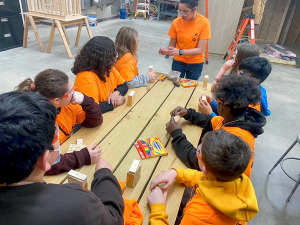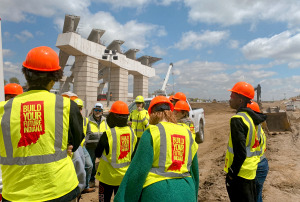Subscriber Benefit
As a subscriber you can listen to articles at work, in the car, or while you work out. Subscribe Now
In more than a dozen school districts across Indiana, construction clubs have formed to interest elementary and middle school students in building-trade careers.
The after-school and weekend programs let students take field trips to construction sites, play games that simulate worksites and build popsicle-stick towers, planters, birdhouses and picnic tables with the help of industry professionals.

It’s part of a larger effort by the Indiana Construction Roundtable Foundation to help mend what is projected to be a gaping hole in the construction workforce.
“Our best projection is that Indiana will need 275,000 construction workers by the year 2026,” said Matthew Nance, the foundation’s director. That means the state will need to add more than 110,000 people to the current workforce of 165,000 due to increasing retirements of baby boomers and rising demand from a statewide construction boom, Nance said.
“The need is going to be across the board,” he said. “All [construction] sectors are going to need the support going forward. We were an ‘essential industry,’ so construction never stopped during the pandemic.”
Nationally, the outlook is similar, and immediate shortages are already being felt.
The construction industry overall needs to attract an estimated 546,000 additional workers beyond the normal hiring pace just this year to meet labor demands, according to the Washington, D.C.-based Associated Builders and Contractors.

Opening young eyes
The Roundtable Foundation’s construction clubs and its other K-12 programming are intended to help address the shortage long term and to open students’ eyes to many well-paying jobs that might not be on their radar, Nance said.
“One of the things we’ve learned in the past few years is, a lot of high school students already have their minds made up about their future careers,” so it’s important to work with younger students, he said.
Younger students need to know about engineering, architecture, solar-panel installation, heavy-machine operating and many other careers, and which high school classes in math, drawing and other disciplines they’ll need to prepare them, Nance said.
The foundation, an independent not-for-profit, was founded in 2015 after the Indiana Construction Roundtable board recognized the importance of addressing the industry’s workforce shortage.
One step was developing Build Your Future K-12 programs to support schools in a variety of ways, including setting up career fairs and providing free classroom materials, videos and training.

Macauley Wieland-Horning, the foundation’s coordinator of K-12 initiatives, said construction clubs focus on giving students real-world, hands-on experiences.
About 16 school districts, including Wayne, Warren and Perry townships, operated clubs this spring that offered 12 hours of mostly after-school sessions of instruction and activities. Several clubs are running this summer, and at least 10 more districts are to offer clubs in the fall.
Gabbie Diaz, 12, a sixth-grader at Stout Field Elementary in Wayne Township Schools, said she participated in the school’s club this year because she was interested in learning more about different careers and because her grandfather, who owns a landscaping equipment company, works in the industry.
She said she enjoyed building a birdfeeder and a small catapult, and learned the importance of working well with others to get projects done.
During a field trip to the district’s Area 31 Career Center, she learned about welding and helped weld two metal rods together. “I didn’t think it was that hard, but it could be dangerous,” she said. While she’s thinking about being a neurosurgeon, Gabbie said she’d also consider welding.
The BYF club “gave our kids experiences that they may have never gotten,” said Andy Archer, Stout Field Elementary math teacher and club organizer. “The club opened our kids’ eyes up to many different jobs that they had never thought they could work toward. The curriculum and each session were very well planned out.”
The foundation also offers free Build Yourself job training for adult learners interested in construction industry careers. The eight-week course includes 16 sessions that provide a mix of classroom and hands-on learning. Adults get training in basic safety, construction math, hand and power tools, construction drawings, basic rigging, and communication skills. Graduates earn two industry certifications, and the class ends with a job fair with industry employers who are hiring, Nance said.

‘Extremely critical’

Construction company leaders and labor union officials also recognize the need to encourage both adults and youth to consider construction careers.
Kevin Hunt, president and chief operating officer of locally based Shiel Sexton Co. Inc., described the need for construction workers as “extremely critical.”
He said several big projects, as well as some “mega” developments costing in the billions, are underway or planned by hospitals, universities and private companies in Indiana, in addition to four major state government projects.
He also cited the Indiana Economic Development Corp.’s aggressive efforts to solicit businesses here and the federal CHIPS Act as additional fuel for the construction boom.
“The workforce is woefully short of being able to keep up,” Hunt said.
He said the company does $30 million in work annually and could grow that revenue 50% with enough workers.
Shiel Sexton sponsors 1,300 classes in person and online to train people, stressing competitive salaries and attractive benefits.

IBEW Local 481, which covers 16 counties in central Indiana, has been working to address the shortage, too, said Lance Bradbury, business representative.
The local has increased the number of apprentices it trains and is actively trying to interest younger workers and make the industry more friendly to women, he said.
“We visit hundreds of high schools a year to let them know how much they can make and get the message out to students and parents,” Bradbury said. He said people can’t believe, for example, that a journeyman-level electrician can make $130,000 a year.
Local 481 officials, he said, have been working hard to expand the workforce because they saw this surge in construction work, particularly for electricians, coming years ago with the increased focus on renewable energy and the rising availability of infrastructure funds.
“I’m 23 years into my career now, and I’ve never seen this much construction work on the books,” Bradbury said.

Indianapolis-based F.A. Wilhelm Construction Co. Inc., which focuses on commercial and industrial work, has made some changes, too, in response to a steady demand for skilled workers, a decrease in high school graduates entering the workforce and an increase in retirees, said Molly Burns, a vice president.
“We spend a lot of time trying to find people who fit well into this industry,” Burns said. The company has broken from the traditional mold of hiring only people with construction-management degrees, she said, and now also recruits people with business and science degrees.
“If they have excellent problem-solving and communication skills, we’ve found they can be trained for project management, IT and project-estimating jobs,” she said.
“We’ve got to get more involved in recruiting people into construction much earlier. We go to high schools, career centers and attend job fairs hosted by workforce development groups,” she added. “There’s a lot of competition for careers and fewer people out there.”•
Please enable JavaScript to view this content.
